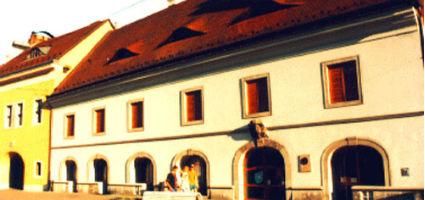2024. May 7. Tuesday
Gallery of Miskolc Museum of Contemporary Art - Miskolc
 |
Address: 3530, Miskolc Rákóczi utca 2.
Phone number: (46) 500-680, (46) 500-681
E-mail: miskolcigaleria@gmail.com
Opening hours: 07.09-31.05.: Tue-Sat 9-17
01.06-06.09.: Tue-Sun 10-18 13.06-24.06.: Tue-Sun 10-23 |
The exhibition has closed for visitors.
2016.01.21. - 2016.02.21.
Museum tickets, service costs:
|
Ticket for adults
|
310 HUF
|
|
|
Ticket for students
|
160 HUF
|
|
|
Ticket for pensioners
|
160 HUF
|
The Transcarpathian School of Painting is a unique, colourful and outstanding artistic community. Transcarpathia based artists' popularity and recognition goes beyond the boundaries of the region. Its art has unique ethnic, local, temporal characteristics, which are rooted in Central and Eastern Europe and lie in the historical layers of the livelihoods of people living there.
The art of Transcarpathia today draws from folk and national aesthetics, from the eternal sources that meant inspiration for major artists such as József Boksay (1891-1975) or Béla Erdélyi (1891-1955). They were the pioneers and founders of the formation and development of art in Transcarpathia. Transcarpathian painters have a distinctive style as the colours and compositional technique they use distinguishes them from other schools. According the painter Pál Balla ofUngvár, who died in 2008 the concept of "Transcarpathian school of painting" as such surfaced in the 1960 first when Soviet art historians inf Kiev and Moscow realized that Transcarpathian painting can not be mechanically classified in the Soviet Union established socialist realism from the principles of "l'art pour l'art. They recognized that it was a special, separate phenomenon is the art of the Soviet Union.
In search of the historic beginning of the Transcarpathian painting collective we should not forget the special atmosphere, North Eastern Carpathians that was known asTranscarpathia after Trianon, its human and geographical characteristics, which in its own way, with its own romanticism, inclusion inspired the inhabitants to create a unique and diverse folk art. This folk art embraced architecture and wood carving - the gems of these are wooden churches in their magical harmony and perfection - pottery, weaving, embroidery, basket weaving and metalwork, not to mention the folk poetry and folk songs.
The destiny of Transcarpathia intertwined with Hungary's histories. The work of "Hungarian Rusyns" (so named the population of Transcarpathia during the Austro-Hungarian Empire) were greatly influenced by artist who studied in major centers, particularly in Budapest and Vienna. Under the guidance of Simon Hollósy the famous painting school of Nagybánya was also operating in Transcarpathia, which had an invaluable impact on the region's art. The distinguished nature of Transcarpathian painting is in the decorative colours and images and its unique space of spiritual fullness. Artists at the school always craved freedom of creative self-expression, rejecting templates.
Since the disintegration of former Soviet Union, the development of art in Carpathia that belongs to Ukraine now is still unassailable, assimilating cultural achievements of generations.
The exhibition featuring paintings by artists from Transcarpathia is on display in Miskolc, organized by the Consulate General of Hungary of Uzhgorod.
The art of Transcarpathia today draws from folk and national aesthetics, from the eternal sources that meant inspiration for major artists such as József Boksay (1891-1975) or Béla Erdélyi (1891-1955). They were the pioneers and founders of the formation and development of art in Transcarpathia. Transcarpathian painters have a distinctive style as the colours and compositional technique they use distinguishes them from other schools. According the painter Pál Balla ofUngvár, who died in 2008 the concept of "Transcarpathian school of painting" as such surfaced in the 1960 first when Soviet art historians inf Kiev and Moscow realized that Transcarpathian painting can not be mechanically classified in the Soviet Union established socialist realism from the principles of "l'art pour l'art. They recognized that it was a special, separate phenomenon is the art of the Soviet Union.
In search of the historic beginning of the Transcarpathian painting collective we should not forget the special atmosphere, North Eastern Carpathians that was known asTranscarpathia after Trianon, its human and geographical characteristics, which in its own way, with its own romanticism, inclusion inspired the inhabitants to create a unique and diverse folk art. This folk art embraced architecture and wood carving - the gems of these are wooden churches in their magical harmony and perfection - pottery, weaving, embroidery, basket weaving and metalwork, not to mention the folk poetry and folk songs.
The destiny of Transcarpathia intertwined with Hungary's histories. The work of "Hungarian Rusyns" (so named the population of Transcarpathia during the Austro-Hungarian Empire) were greatly influenced by artist who studied in major centers, particularly in Budapest and Vienna. Under the guidance of Simon Hollósy the famous painting school of Nagybánya was also operating in Transcarpathia, which had an invaluable impact on the region's art. The distinguished nature of Transcarpathian painting is in the decorative colours and images and its unique space of spiritual fullness. Artists at the school always craved freedom of creative self-expression, rejecting templates.
Since the disintegration of former Soviet Union, the development of art in Carpathia that belongs to Ukraine now is still unassailable, assimilating cultural achievements of generations.
The exhibition featuring paintings by artists from Transcarpathia is on display in Miskolc, organized by the Consulate General of Hungary of Uzhgorod.